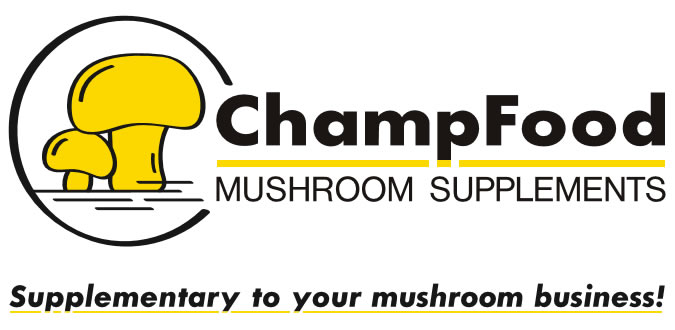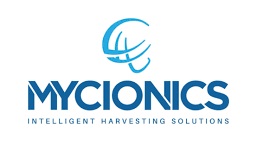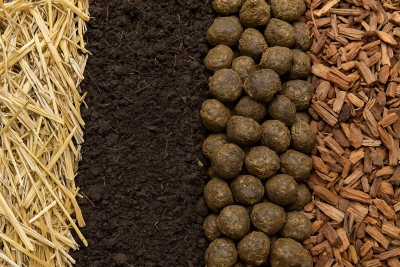The recent shortage of straw and hay in parts of North America and Europe has sparked a flurry of questions regarding what can be used as a substitute for compost ingredients. We thought a quick review of materials listed by Dr. Lee Schisler at the North America Mushroom Conference in the 80s and other materials that may be available around North America and elsewhere would be of some interest. There may be materials that we are not discussing that could be used as compost ingredients, but most likely in areas where better materials are not readily available.
Bulk Ingredients
Straw, whether it be straight wheat straw or bedded horse-manure straw, is the most common bulk ingredient used around the world. Other varieties like barley and rye can be used, although composting practices will need to be modified for these types of straw. The nitrogen, cellulose, hemicellulose, and lignin content of these straws may vary based on the variety, but differences are probably more related to where and how it is grown. Rice straw, although used in SE Asia, is generally not a desirable material as it is physically short, tough, and hard to break down. Oat straw is also a poor material; as it composts, it quickly becomes flat and soft, contributing to anaerobic conditions. Sorghum and sugar cane fodder can be used, but the stalks should be physically crushed before starting the composting process.
Corn fodder is starting to be used; our research has suggested 25% might be the most one could add to a straw-hay formula without negatively influencing yields. Its structure may also limit its use in systems that do not physically chop the fodder. In Pennsylvania and parts of Canada, mulch hay is a common bulk ingredient, timothy and orchard grasses being the most common varieties. Alfalfa can be used, but it is higher in N and physically can be more challenging to compost. Generally, in hay-based formulas, other bulk ingredients are used to provide additional carbohydrates to the formula. These bulk ingredients include corn cobs (ground or pelletized), cottonseed hulls (as is or pelletized). Less common are items such as hardwood bark or chips; deciduous leaves are used seasonally at one progressive farm, but the collection and storage of this material are challenging. Potato peel and slicer waste has been reported to be an option, but it is probably not commonly used because of problems associated with handling and storage of these high-moisture materials.
Other bulk ingredients that have been tried include peanut and rice hulls, but they are very high in lignin and hard to break down in the short composting times found at most commercial farms. Softwood barks have compounds (phenolic?) toxic to Phase 2 microbes and mushroom mycelium. Kenaf core, a by-product of the fiber collection process, and recycled paper wastes are possible ingredients, but at low amounts, say no more than 5-10% of the total volume. Additional research should be conducted, as paper waste is much different today than when this work was first reported in the 1970s. At this time, we consider spent mushroom compost as a filler material with no useable nutrients or used as an avenue to dispose of small quantities; however, research is being done to determine if larger quantities can be used as a bulk ingredient or as a supplement. Mushroom stumps are often disposed of in compost, but add little to the value of the compost.
Supplements
The “inorganic” sources of nitrogen, those with no carbohydrates, are historically used in synthetic formulas only and at no more than 25 lbs. per dry ton of other ingredients. The most common and only one still readily available is urea, often used with straight wheat straw formulas as a starter ingredient to “soften” the straw early in the pre-conditioning process. Calcium Cyanamid has been reported to be a substitute but must be pH adjusted and is not a commonly available ingredient, and hence not widely used. These inorganic supplements need to be added early in the composting process and are not readily available to the Phase II microbes.
More “organic” supplements, ones with carbohydrates readily available, are valuable but more expensive and therefore generally used later in the composting process to ensure there is a balanced formula. These ingredients include more common materials such as brewer’s and or distiller’s grain, cocoa bean hulls (contain an oil that microbes like), cottonseed meal, bedded poultry manure, ground soybean, rapeseed screenings, and sugar cane bagasse. Poultry manure for broilers is most common, but layer poultry manure, dried and processed, may also be used. The nitrogen content of poultry manure may vary depending on the source, number of flocks bedded on it, and other factors, so it is suggested to analyze the N content on a regular basis. Liquid poultry manure is used in some tunnel facilities that are designed to handle it. Rapeseed oil meal (expeller or solvent) or screenings are more likely to be available in the northern states and in Canada.
Other not so common supplements would be brewers dried yeast, buckwheat millings, castor bean meal, corn gluten feed (include bran), corn gluten meal, feather meal, fish solubles, linseed oil meal (Flax seed), malt sprouts, peanut oil meal, safflower oil meal (expeller or solvent), sesame oil meal (expeller or solvent), single cell protein, soybean screenings, soybean oil meal (expeller or solvent), cocoa hulls, sugar beet pulp (source of carbon), sunflower oil meal (expeller or solvent), wheat bran, wheat germ meal, and wheat mill run. Feather meal is high in N, so it is important to have a good distribution in the mixing. Fish solubles are high in moisture and difficult to handle.
Other feedlot manures can be used if generously bedded on straw with an effective pre-conditioning period, although I know of a small hobbyist grower who was composting straight cow manure (no straw) and successfully growing mushrooms. Blood meal has nitrogen, but in a form that has very little available to the microbes in Phase II. Apple pumice and paunch are too acidic and easily go anaerobic; therefore, they would not be adding desirable characteristics to the formula.
As you can see, there is a wide variety of raw materials available, and it is up to each of you to decide what works. What works in one part of the world, or at one farm, might not necessarily work in a different system. Material availability and economics will also play an important role in deciding what raw materials work for you.
Supplements and raw bulk ingredients for mushroom composting
Jun 24,
2025
Latest from Mushroom Matter
- e-nema at the Mushroom Days: natural power for healthy mushrooms
- Possible mechanisms involved in the fruiting of the cultivated mushroom - by David M. Beyer
- From concept to capability: how integrated robotics are redefining mushroom harvesting
- Latest newsletter
- If you remove the mushroom, nature falls apart






















